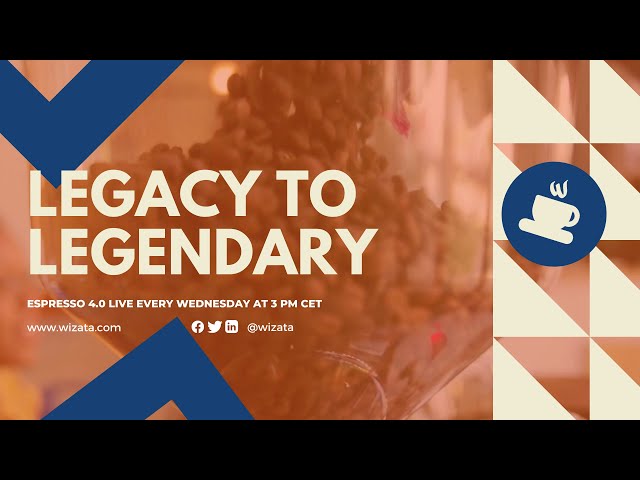![]() Espresso 4.0 by
Espresso 4.0 by
Wizata
We discussed how one goes from Industry 3.0 to Industry 4.0. From simply not consuming any data from the production to fully automated production and processes. What is the road map? How do we get there? I heard someone say, “going from legacy to legendary.” How does that work?
Automation steps
Of course, this is not a “one rule fits all” situation. It depends on the domain, the strategy that you want to achieve, and the final goal. But, there are some layers you can tackle in a reasonable or logical way, step by step.
Collecting and connecting the data
The first layer is to have data and connect your data in real-time to a platform that can orchestrate different kinds of technologies. So not only IoT but also Artificial Intelligence and, of course, the ability to interact with your data, not just visualize it.
Vizualizing your data
Smart monitoring would be the second layer. Visualizing your data in a digital twin, for example, giving context and centralizing your data, and seeing the interaction between the different processes and the different assets.
Anomaly prediction
Then we move forward to what we normally call the descriptive layer for root cause analysis. We try to make sense of what is happening in the data - what the data shows us and why something is happening. Is it a quality issue? Is it a failure?
Once we know what exactly is happening, we can figure out ways to predict and prevent it. So, we have an additional layer which is the protective one.
We can predict failure and anomalies, so we can take action before they happen and create a downtime or unexpected stoppage.
Recommendation stage
After the preventive layer, we have what we call the prescriptive layer, or the recommendation stage, where the AI algorithm is able to send recommendations to avoid those specific issues from happening.
At the recommendation stage, a human being is still involved in evaluating whether these recommendations are good. For example, a recommendation could be “input this value into the set point.” A job of a human layer is to evaluate whether this value makes sense or not.
The final stage of automation
The final step, which of course, is the one that brings more value, is the automation layer. In this chain of layers, the more we go up, the more value it brings in ROI. The algorithm is able to manage and control the input and output values in the asset. These layers are actually what brings us from nothing to automation.
Predictive analytics
We always talk about predictive maintenance, and many people describe predictive maintenance as low-hanging fruit. Something that's rather easily achievable; therefore, many solution providers go for that as their main selling point.
That's why I prefer the term predictive analytics. More of an umbrella term, encompassing not only maintenance but also quality. Some people even coin the term Quality 4.0, for instance.
So, what are some of the benefits that predictive analytics AI can bring to a business outside of maintenance?
Predicting quality, predicting whether a defect will happen or not, or whether there will be a likelihood that a specific defect will happen, will give the operators and engineers the knowledge to adapt the different variables on the line.
For example, the algorithm predicts that oxidation will happen on the line. In that case, the operators know what action to take to avoid this oxidation. Of course, this is due to the knowledge, experience, or wisdom that the operator has.
These things can also be done by logic itself. And here we loop back to automation. If the system predicts that there will be oxidation in an automated AI control loop, the logic itself will take action to avoid that oxidation.
All these steps are connected to each other. It's just the level of maturity or advancement that we set as a final target. And we always recommend, based on our experience, to go step by step.
Of course, we can shoot for immediate automation. This depends on the stakeholders, the company's strategy, and the available resources. But normally, doing something gradually is the way to go.
What comes next?
What do fully automated companies that have reached the very end step of this road map stand to gain, if anything, from industry 4.0, or are they already industry 5.0? Are we looking into the next step of digitalization?
The natural way forward after automation is to replicate and scale the same technology and logic to other equipment, other assets, and geolocations within the corporation.
Of course, scalability is something that you can do at each step. It doesn't have to happen only when you have automation in place. It can be done with the root cause, or it can be done with preventive, predictive, maintenance, and so forth.
Ideally, if you automate a kiln or a blast furnace, you can easily replicate the same automation to a similar technology or oven. Of course, this will always require an algorithm adaptation because each oven or each asset is slightly different. They may be different generations, operations, or different kinds of data.
So there will always be some flexibility and fine-tuning necessary, but it's easier to use something that already exists and adapt it rather than starting it from scratch.
In conclusion, there's a lot of work to be done depending on where you are within the spectrum. There is a pathway forward and a way to further optimize your production and gain value from data coming from your assets.




